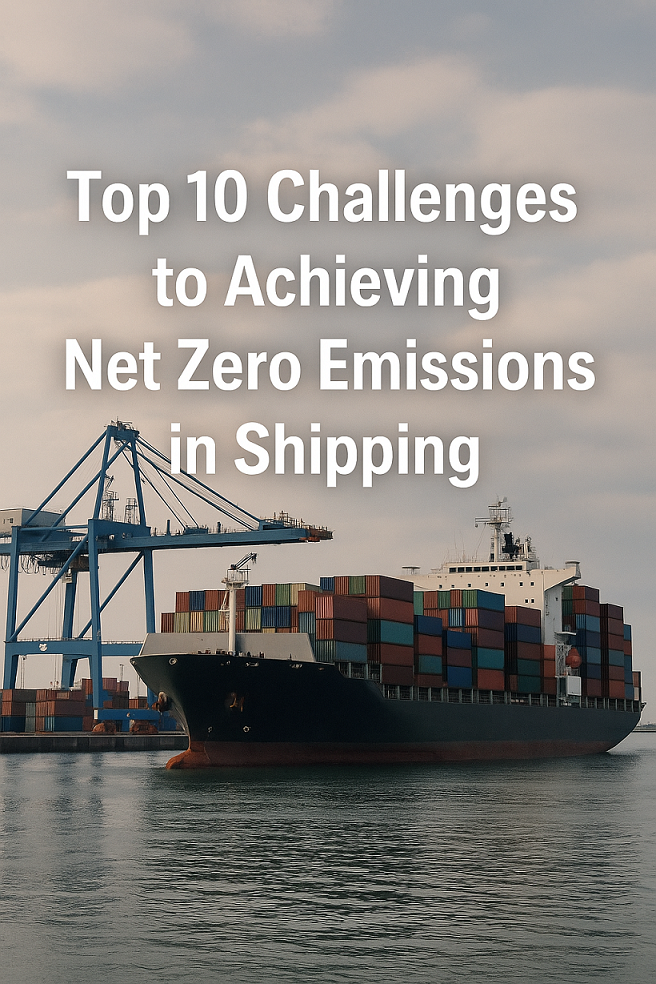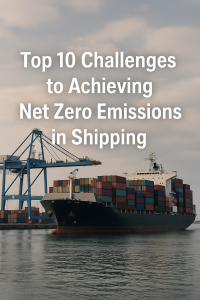Discover the top 10 challenges to achieving net zero emissions in shipping. Learn about regulatory, technical, economic, and operational hurdles facing the maritime industry on the path to decarbonization.
Why Net Zero Emissions Matter in Modern Maritime Operations
Shipping is the backbone of international trade, moving over 80% of global goods. But it also accounts for nearly 3% of global greenhouse gas (GHG) emissions. As climate targets tighten globally—particularly under the Paris Agreement—the shipping industry faces growing pressure to reduce its carbon footprint.
The International Maritime Organization (IMO) has set a goal to reduce total GHG emissions from international shipping by at least 70% by 2050 (from 2008 levels), with a vision toward net zero emissions around or close to that date. This ambition is supported by the IMO’s revised GHG strategy, adopted in July 2023.
Despite progress in energy efficiency and cleaner fuels, achieving true net zero remains one of the maritime industry’s greatest technical and economic challenges. Shipowners, regulators, technology providers, and financial institutions all face significant hurdles.
The 10 Major Challenges to Achieving Net Zero Emissions in Shipping
1. Lack of Scalable Zero-Carbon Fuels
The Problem: While alternatives like green ammonia, hydrogen, and methanol are in development, they are not yet produced at the scale required to serve the global fleet.
Key Insights:
-
Green hydrogen-based fuels are expensive and limited by renewable energy input.
-
Infrastructure for bunkering these fuels is practically non-existent outside pilot ports.
Real-World Example: Maersk’s methanol-powered vessels are leading the transition, but global methanol availability remains inadequate.
External Reference: DNV Maritime Forecast to 2050
2. High Costs of Fuel and Technology Transition
The Problem: Alternative fuels are up to 4–6 times more expensive than conventional marine fuels. Retrofitting or building new vessels to use these fuels also requires major capital investment.
Case Study: Retrofitting a bulk carrier with LNG and scrubber systems can exceed $10 million.
Financial Challenge: Small and medium shipowners lack access to green financing, unlike major shipping conglomerates.
Keyword Focus: fuel transition costs, green ship retrofitting
3. Fragmented and Evolving Regulatory Landscape
The Problem: While the IMO is the central regulatory body, regional efforts like the EU Emissions Trading System (EU ETS) and FuelEU Maritime create complexity.
Impact:
-
Shipowners may face overlapping or conflicting emissions rules.
-
Compliance burdens differ by flag state, port state, and trading region.
Link: IMO GHG Strategy
4. Slow Technology Commercialization and Certification
The Problem: New technologies like onboard carbon capture or hydrogen propulsion systems are still in pilot phases and not yet certified for widespread use.
Barrier:
-
Long validation timelines by classification societies.
-
Safety and liability issues for high-risk fuels like ammonia.
Institutional Insight: Class societies like ABS and DNV are still developing guidelines for next-gen fuel readiness.
5. Insufficient Global Port Infrastructure
The Problem: Most global ports lack the bunkering facilities and safety protocols needed for ammonia, hydrogen, or even methanol.
Example: Rotterdam and Singapore are among the few ports investing in green fuel infrastructure, but global coverage is fragmented.
Keyword Focus: green port infrastructure, zero-carbon fuel logistics
External Link: Port of Rotterdam – Hydrogen Hub Strategy
6. Limited Shipyard Capacity and Skilled Labor
The Problem: Global shipyards are overwhelmed with retrofitting and newbuild orders. Skilled personnel in green engineering, fuel systems, and automation are in short supply.
Stat Insight: According to the ICS, a 30% increase in maritime technical staff will be required by 2030 to meet green fleet demands.
Solution Needed: Investment in maritime vocational education and digital training platforms.
7. Slow Fleet Turnover and Asset Lifespan
The Problem: Ships often operate for 20–30 years. Without incentives or regulation, many owners delay replacing older, high-emission vessels.
Economic Dilemma: Selling or scrapping fully functional ships is financially unattractive unless regulatory pressure makes it unavoidable.
Reference: Lloyd’s List Intelligence – Fleet Modernization Reports
8. Uncertainty Around Fuel Choice and Stranded Asset Risk
The Problem: With no clear winner among alternative fuels, shipowners hesitate to invest, fearing that their choices may become obsolete.
Example: A vessel built for LNG today may be sidelined by 2040 due to methane slip concerns or policy changes.
Keyword Focus: fuel-agnostic ship design, stranded maritime assets
Analogy: It’s like investing in VHS just before the world went digital—technically sound, but strategically outdated.
9. Weak Carbon Pricing and Market Incentives
The Problem: Without robust carbon pricing or enforceable emission taxes, polluting fuels remain the cheapest and most profitable option.
Current Measures:
-
EU ETS inclusion of shipping from 2024
-
Poseidon Principles tying finance to emissions performance
Gap: No global carbon tax framework yet under the IMO.
External Link: Poseidon Principles – Climate-Aligned Finance
10. Operational Complexity in Carbon Accounting
The Problem: Accurately tracking and reporting emissions across supply chains, voyages, and multi-fuel systems is complex.
Regulatory Requirement: From 2023, IMO Data Collection System (DCS) and EU MRV require detailed CO₂ reporting.
Emerging Role: Demand is rising for Environmental Compliance Officers and ESG auditors across shipping companies.
Reference: EU MRV Regulation
–
Real-World Application: Evergreen Marine’s Hybrid Decarbonization Strategy
Evergreen Marine is addressing decarbonization through:
-
LNG dual-fuel newbuilds
-
Onboard solar energy for auxiliary power
-
Real-time fleet performance monitoring
Despite challenges in sourcing green LNG and port compatibility, Evergreen has reduced GHG intensity by 18% since 2018 and is actively collaborating with Taiwanese authorities on ammonia bunkering projects.
FAQ – Challenges to Net Zero in Maritime Shipping
Q1: Is it technically possible to reach net zero emissions in shipping?
Yes, but only with massive global cooperation, technological breakthroughs, and supportive market conditions.
Q2: Which fuel is most likely to dominate the future?
Uncertain. Methanol, ammonia, and hydrogen all have potential, but availability, cost, and safety are major factors.
Q3: Will small shipowners be left behind?
Unless policies ensure equitable access to funding and tech, smaller operators may face existential threats.
Q4: Are classification societies helping or slowing down the process?
Both. They ensure safety but are inherently conservative, which can delay innovation deployment.
Q5: Are governments doing enough?
Efforts vary by region. The EU and Singapore are leading, while others lag in offering incentives or infrastructure support.
Q6: How long will it take for net zero shipping to become mainstream?
Industry experts suggest 2040s–2050s, but transitional progress must occur within this decade.
Conclusion: From Ambition to Action—Overcoming the Barriers
Achieving net zero emissions in shipping is not a technological dream—it’s a strategic necessity. But it requires overcoming a complex web of economic, regulatory, logistical, and behavioral barriers.
Shipowners, regulators, financiers, and technology innovators must collaborate—not just in rhetoric but in real, coordinated action. From global carbon pricing to modular ship designs and scalable green fuels, each solution must be deployed systematically and equitably.
The voyage to net zero won’t be easy—but it is navigable, and delay is no longer an option.


